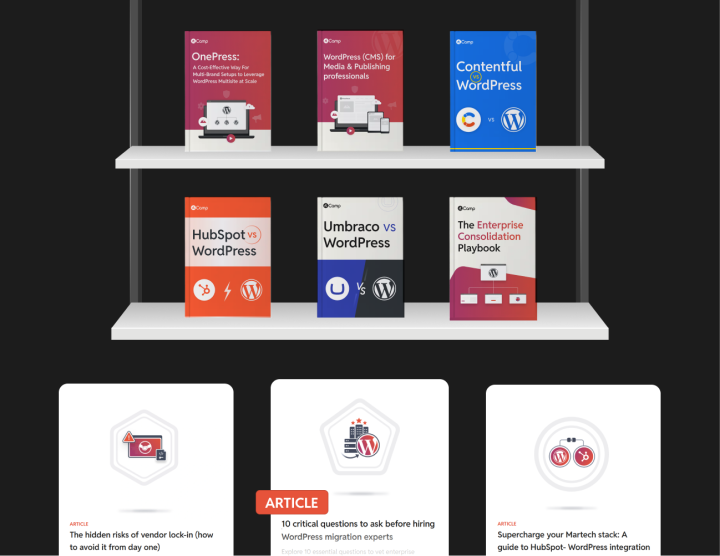Sanity CMS vs WordPress: Setup, configuration and deployment
Choosing a CMS isn’t just about the features, it’s about how easily you can get started and keep things running smoothly. The setup and deployment process can influence how quickly your team can begin creating and managing content. Comparing Sanity vs WordPress, WordPress emerges more accessible for a wider range of users.
Sanity: Developer-focused
Sanity is built for developers who value control and flexibility. As a headless CMS, it focuses on delivering content through APIs.
Prerequisites for Sanity
To begin with Sanity headless CMS, you need:
- Node.js installed on your system, as the Sanity CLI runs on JavaScript.
- A basic understanding of using the terminal for commands.
- A Sanity account, which can be set up for free on their cloud-based platform.
This setup reflects Sanity’s developer-first philosophy, requiring some familiarity with coding and CLI tools.
Installation and initial setup
The installation process starts with installing the Sanity CLI. Once that’s done, setting up a project is as simple as running a few commands. Here’s what the process looks like:
- Install Sanity CLI: You start by installing the CLI tool using npm, a popular package manager for JavaScript. This provides you with commands to create and manage your Sanity project.
- Initialize the project: The command sanity init sets up a new project. You’ll be prompted to name your project, choose a template (e.g., blog or e-commerce), and link it to your Sanity account. At the end of this step, you’ll have a functional project directory.
- Customize your content: Sanity’s strength lies in its flexibility. Using JavaScript, you define schemas for your content. For example, a blog post schema might include fields like title, author, and date. These schemas dictate how your content is stored and accessed.
- Start Sanity Studio: Once your project is ready, running the sanity start command launches Sanity Studio. This is your customizable content management interface, hosted locally during development.
Deployment process
Sanity deploys with its cloud-based Content Lake. You don’t need to manage a backend or database yourself. When it’s time to go live, you’ll:
- Build the static files for Sanity Studio using sanity build.
- Deploy these files to a hosting service like Vercel or Netlify.
- The backend (Content Lake) is already managed by Sanity, handling scalability, backups, and updates seamlessly.
This process is ideal for teams focused on delivering custom, scalable digital experiences without the burden of managing infrastructure.
WordPress: Accessible and flexible
WordPress is widely regarded as the most user-friendly CMS, offering a simple yet powerful setup process. WordPress makes it easy to get started, whether you’re a beginner creating your first website or an enterprise looking for scalability. Its intuitive interface caters to users with minimal technical knowledge, while advanced features and plugins make it a go-to choice for businesses.
Prerequisites for WordPress
Before you begin, you’ll need:
- A hosting provider: Choose one that supports PHP and MySQL (most do). Some providers, like Bluehost and Hostinger, even offer one-click WordPress installations.
- A domain name: This is your website’s address on the internet.
- Optional: Basic knowledge of web hosting or file management if you’re going the manual installation route.
Many hosting services bundle these prerequisites, so you won’t need to configure them.
Installation and initial setup
Setting up WordPress is simple and can be done in a few ways: using a one-click installer, manually, or via managed hosting services.
1. One-click installation
This is the fastest and easiest option. Many hosting providers like Hostinger, SiteGround, and Bluehost offer one-click WordPress installations. Once you log in to your hosting dashboard:
- Locate the WordPress installer (usually under “Website” or “Auto Installers”).
- Click “Install,” choose your domain, and fill in some basic details like your site name and admin credentials.
- Within minutes, your WordPress site is live.
2. Manual installation
For a more hands-on approach:
- Download WordPress: Get the latest version from WordPress.org.
- Create a database: Use your hosting control panel or phpMyAdmin to set up a database for WordPress. Note down the database name, username, and password.
- Upload files: Use an FTP client (e.g., FileZilla) or your hosting file manager to upload the WordPress files to your server’s root directory.
- Run the installer: Visit your domain in a browser. WordPress will guide you through the installation process. Enter your database details, set your site title, and create an admin account.
3. Managed hosting
Managed hosting services like WordPress VIP and Pagely handle everything for you be it setup, updates, backups, and security. This option is great for enterprises or users who want a hassle-free experience.
Headless WordPress setup
If you’re looking to decouple WordPress and use it as a headless CMS:
- Install plugins: Add the WPGraphQL plugin for GraphQL APIs or use the built-in REST API.
- Build the frontend: Use frameworks like React, Gatsby, or Next.js to create the frontend of your site.
- Connect APIs: Fetch your WordPress content using API endpoints for dynamic and flexible frontends.
This approach gives you the flexibility to serve content across multiple platforms while maintaining WordPress as your backend.
Deployment process
Deployment depends on how you choose to host WordPress:
Self-hosted: If you’re managing your hosting:
- Upload WordPress files via FTP or your hosting dashboard.
- Configure your database connection in the wp-config.php file.
- Regularly update WordPress core, themes, and plugins to maintain security.
Managed hosting: Providers like WordPress VIP or Pagely offer streamlined deployment. They handle updates, backups, and performance optimization, letting you focus on content and functionality.Hybrid deployment: If you’re using WordPress as a headless CMS, deploy your frontend (built with React or similar frameworks) to hosting services like Vercel or Netlify. Pair this with a managed WordPress backend for optimal performance and scalability.







